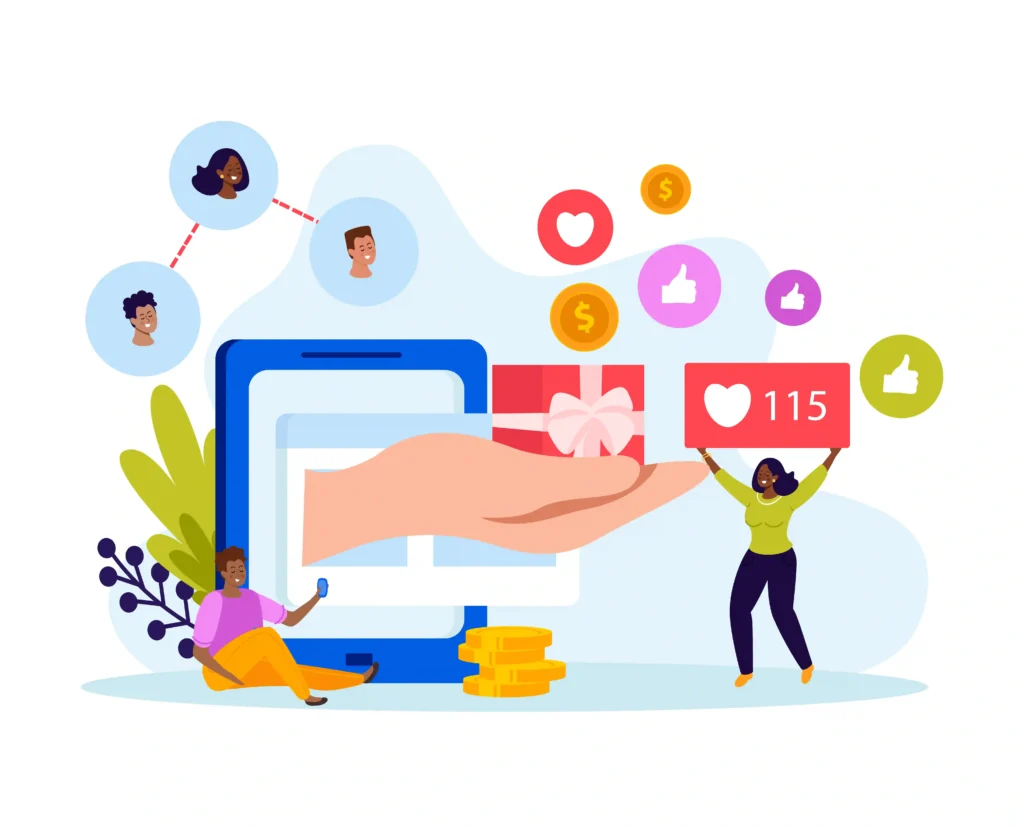Social media marketing is now a key part for both big and small businesses. With 4.9 billion people using social media globally, it’s a great way to connect with customers. It helps across all industries to find your target audience, boost your brand, gain loyal customers, and make more money. This guide is here to teach you all about social media marketing. It covers what it is, how it helps, the top tactics, and how to put it all into practice.
Key Takeaways
- Social media marketing is a powerful tool for connecting with your target audience and growing your business.
- Developing a strategic, well-planned social media marketing approach is crucial for success.
- Effective social media marketing involves understanding your audience, creating engaging content, and consistently measuring and optimizing your efforts.
- Leveraging paid social media advertising can help you reach a wider audience and achieve specific marketing objectives.
- Regularly analyzing your social media marketing performance using analytics tools is key to making data-driven decisions.
What is Social Media Marketing?

Definition and Overview
Social media marketing helps your brand reach out to customers through platforms like Facebook and Instagram. It’s not just about posting randomly. For it to work well, you need to plan carefully.
Key Components of Social Media Marketing
First, you make profiles for your business. Then, you keep them up-to-date and interesting. You also plan what content to post, including text, pictures, videos, and stories. This content should make your brand look good and attract the right people.
Part of keeping a good profile is interacting with your followers. You respond to their comments, likes, and shares. This helps you manage your online image and hopefully form a community. You might also run paid ads to target specific audiences if it fits your budget and goals. Successful social media marketing involves knowing your audience, shaping your brand identity, planning your content, checking how well you’re doing, and being active all the time.
Benefits of Social Media Marketing
Social media is great for marketing your business. It is both popular and versatile. Unlike traditional methods like ads, it lets you measure your success well. This is important because it allows you to see how well your efforts are working. It can help your business in many ways. For example, it can make your business feel more personal. It can drive more people to your website. It can also help create new leads and grow your brand. Plus, it’s a good way to connect with your customers.
Increase Brand Awareness
Social media lets you talk to people who are already your customers and those who might become customers. If you use it right, it can make your brand seem more real to people. This can help build stronger ties between you and your audience. These stronger ties can help keep customers around for a long time. Since social media makes it easy to talk to your followers, it’s a great tool for building these strong relationships.
Foster Customer Relationships
On platforms like Facebook and Instagram, you can do many helpful things. You can let people book appointments directly on these sites. You can add calls-to-action that encourage people to act. And you can even talk to customers directly through messages. All of these can help turn your online chats into actual sales. Connecting your website to your social media posts is also key. It brings more people to your site, which can help your site show up more in online searches. This, in turn, can lead more visitors to become buyers.
Generate Leads and Drive Sales
On platforms like Facebook and Instagram, you can do many helpful things. You can let people book appointments directly on these sites. You can add calls-to-action that encourage people to act. And you can even talk to customers directly through messages. All of these can help turn your online chats into actual sales. Connecting your website to your social media posts is also key. It brings more people to your site, which can help your site show up more in online searches. This, in turn, can lead more visitors to become buyers.
Popular Social Media Platforms
There are lots of social media platforms you can use in your social strategy. You should look for ones that match your brand and audience well. Face Facebook is a top pick, with many users and great advertising options. It’s ideal for increasing brand awareness, followers, leads, and sales.
Facebook leads the social media world, connecting nearly 4.9 billion people. It helps businesses reach their followers, boost their brand, and sell more products.
Originally, Instagram was for sharing pictures. Now, it’s a key spot for engaging followers with eye-catching photos and videos. It has various features like stories and shops to enhance your marketing. For businesses that rely on visuals, Instagram is a must.
Twitter lets you write short posts called “tweets” with text, pictures, and links. It’s great for quickly sharing news, tips, and more with your audience. Depending on your business, you can use it for customer service, increasing brand awareness, or learning more about your industry.
YouTube

YouTube is a must if you can create interesting videos. It’s the second biggest search engine and a key space for video content. With YouTube, you can explain things in detail, show interesting events, and highlight your products. It’s perfect for adding videos to your social media plan.
Social media marketing tips
To succeed with social media marketing, you need a strong strategy. A social media strategy is like a roadmap for your online goals. It outlines your objectives, actions, and how you’ll measure success. This step is vital for knowing your purpose, be it attracting new customers, launching a product, or increasing brand awareness.
Define Your Goals and Objectives
Setting clear objectives is key. It tells you the reason behind your actions. Whether you aim to draw in customers, highlight a new product, or increase brand visibility, you must have a clear goal.
Understand Your Target Audience
Know your audience inside out. Understanding their needs, behaviors, and favorite social media sites helps. Tools like Semrush’s Social Tracker can provide deep insights into both your audience and your competitors’.
Create a Content Strategy
Your content plan is vital for brand growth. Decide what content to make, how to present it, and the best times to share. A detailed strategy is more likely to get results.
Content Creation and Curation

The content draws your audience’s attention and makes them engage with your brand. You might think trendy posts or videos are the way to go. But, they might not connect with your intended viewers. It’s key to offer value. This can be through educational, fun, or inspiring content. You can use various forms like text, images, videos, and more.
Types of Content for Social Media
What you post on social media affects your marketing plan a lot. Whether it’s a catchy image or deep text, your content should cater to your followers’ tastes and your brand’s character.
Best Practices for Creating Engaging Content
Creating engaging social media content requires a few steps. Make your posts visually appealing and true to your brand. Visuals should stand out and the message should be clear. Add interactive stuff like polls to get people involved. Also, don’t be afraid to reuse your best material or to try new things.
Scheduling and Publishing
Posting regularly on social media is key for marketing success. Make a social media content calendar. This document shows when and what you’ll post on which platform. It keeps your content fresh and on point. Think about when your followers are most active, big events, and when you’re free to post.
Tools that let you schedule and automate your social media posts are a lifesaver. They keep your accounts busy, even if you’re not there to post live. Great services like Hootsuite, Sprout Social, and Buffer cover many of the top social sites.
| Platform | Recommended Post Frequency | Optimal Scheduling Times |
|---|---|---|
| About once a day | Weekdays mid-morning and mid-afternoon | |
| 1-2 posts a day | Weekdays lunchtime and early evening | |
| X | 2-5 times a day | Weekdays late morning and early evening. Wednesday and Thursday are most active. |
| 3-5 times per week | Weekdays mid-morning and lunchtime, especially on Tuesdays, Wednesdays, and Thursdays | |
| TikTok | 1-4 times a day | Evenings between 8 PM and 11 PM. Weekends, especially Saturday nights, are popular. |
Engagement and Community Management
Social media marketing is more than posting. It’s about connecting with your audience. You should quickly respond to comments and messages, showing you care about what they say. This builds social media engagement for your brand. Answer genuinely and helpfully. Make it a chance to provide support, gather feedback, or just talk.
Building a community doesn’t just happen by waiting for interaction. Encourage people to create content, like hosting Q&As or using AMA sessions, and promote your own hashtags. This makes your audience feel closer to your brand. Keep in touch with them, highlight your followers, and share special content or deals. With this, you create a strong community management for social media. This approach can grow your brand’s influence and turn customers into faithful supporters.
Measuring and Analyzing Results
To see how well your social media marketing is doing, keep an eye on certain metrics. Important ones to watch include reach, impressions, engagement rate, click-through rate, website traffic from social, and conversion rate. These numbers will tell you what’s effective, what needs work, and help choose better content and strategies.
Social Media Analytics Tools
Use tools like Semrush’s Social Tracker to get more details about your performance online. They show you who’s looking at your content, how well your posts are doing, and how you compare to others. With this data, you can tweak your social plan for better outcomes.
| Metric | Description | Example |
|---|---|---|
| Reach | The total number of unique accounts that have seen your content | A non-profit organization’s environmental infographic on Facebook was widely shared, increasing their reach and amplifying their message. |
| Impressions | The total number of times your content has been displayed | A small business running Facebook ads noted high impressions but low engagement, suggesting a need to refine their targeting strategy. |
| Engagement Rate | The percentage of your audience that interacts with your content | A clothing brand saw high engagement rates on an Instagram post showcasing a behind-the-scenes look at a photoshoot, indicating a strong connection with the audience. |
| Click-Through Rate (CTR) | The percentage of people who click on your content or ads | An online retailer identified that posts with clear calls-to-action and attractive product images had higher click-through rates during a seasonal sale promotion. |
| Website Traffic from Social | The amount of traffic your website receives from your social media channels | The addiction treatment center experienced a 700% increase in comments and a 255% increase in likes on Instagram after implementing a social media marketing strategy. |
| Conversion Rate | The percentage of your audience that completes a desired action, such as making a purchase | A travel agency observed higher conversion rates on Instagram posts featuring user-generated content, leading to adjustments in their content strategy to boost conversions. |
Paid Social Media Advertising

Businesses use paid social media advertising to reach a bigger group of people and meet marketing goals. The main platforms for this are Facebook, Instagram, Twitter, LinkedIn, and TikTok. These platforms allow for specific targeting, various ad types, and tools to check ad performance.
Social Media Ad Platforms
Facebook, Instagram, Twitter, LinkedIn, and TikTok offer different ways to advertise. Facebook and Instagram focus on getting more attention, involvement, visits, leads, and sales. They use formats like Messenger ads, carousels, photos, and videos. TikTok’s ads aim at getting more exposure, visits, video views, and sales, with options ranging from images to carousels. Twitter helps you reach people, views videos, and directs traffic to your site. LinkedIn is good for spreading the word about your brand, gathering leads, and leading people to your site.
Targeting and Optimization Strategies
Create specific targeting plans based on who you want to see your ads. This can include details like age, preferences, actions, and where they live. Keep testing and improving what your ads look like, say, who they target, and how much you pay. Look at the detailed data the platforms give you to make changes and do better. With a smart, data-first targeting and betterment plan, you can make your paid social ads do a lot more.
Conclusion
Social media marketing is key for all companies these days. It helps build awareness, connect with customers, find leads, and boost sales. By planning your social media carefully, and knowing your goals and audience, you can succeed. It’s about creating content that grabs attention and tweaking your strategy as needed. This way, you can make the most of social media to grow your business.
Focus on the platforms your audience uses most and keep your brand consistent. Make sure your content adds value to your followers’ lives. With the right strategy, social media can be a great, affordable way to reach and connect with your customers.
The conclusion of your plan should remind people what’s most important. You should encourage them to take a next step. By pulling together the main ideas and prompting action, you can make a big impression. This will motivate your audience to keep interacting with your brand.
FAQ
What is social media marketing?
What are the key components of social media marketing?
What are the benefits of social media marketing?
What are some popular social media platforms for businesses?
What are some tips for effective social media marketing?
Make clear what you want to achieve and who you’re talking to. Plan what you’ll share, then check what works and do more of that.

